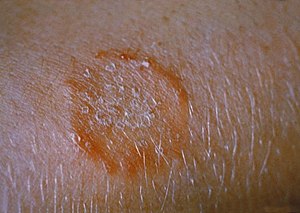Tinea corporis
| Tinea corporis | |
|---|---|
 |
|
| This patient presented with ringworm on the arm, or tinea corporis due to Trichophyton mentagrophytes. | |
| Classification and external resources | |
| Specialty | Dermatology |
| ICD-10 | B35.4 |
| ICD-9-CM | 110.5 |
| DiseasesDB | 29138 |
| MedlinePlus | 000877 |
| eMedicine | derm/421 |
Tinea corporis (also known as ringworm,tinea circinata, and tinea glabrosa) is a superficial fungal infection (dermatophytosis) of the arms and legs, especially on glabrous skin; however, it may occur on any part of the body.
It may have a variety of appearances; most easily identifiable are the enlarging raised red rings with a central area of clearing (ringworm). The same appearances of ringworm may also occur on the scalp (tinea capitis), beard area (tinea barbae) or the groin (tinea cruris, known as jock itch or dhobi itch).
Other classic features of tinea corporis include:
Tinea corporis is caused by a tiny fungus known as dermatophyte. These tiny organisms normally live on the superficial skin surface, and when the opportunity is right, they can induce a rash or infection.
The disease can also be acquired by person-to-person transfer usually via direct skin contact with an infected individual. Animal-to-human transmission is also common. Ringworm commonly occurs on pets (dogs, cats) and the fungus can be acquired while petting or grooming an animal. Ringworm can also be acquired from other animals such as horses, pigs, ferrets and cows. The fungus can also be spread by touching inanimate objects like personal care products, bed linen, combs, athletic gear, or hair brushes contaminated by an affected person.
Individuals at high risk of acquiring ringworm include those who:
Superficial scrapes of skin examined underneath a microscope may reveal the presence of a fungus. This is done by utilizing a diagnostic method called KOH Test, wherein the skin scrapings are placed on a slide and immersed on a dropful of potassium hydroxide solution to dissolve the keratin on the skin scrappings thus leaving fungal elements such as hyphae, septate or yeast cells viewable. If the skin scrapings are negative and a fungus is still suspected, the scrapings are sent for culture. Because the fungus grows slowly, the culture results do take several days to become positive.
Because fungi prefer warm, moist environments, preventing ringworm involves keeping skin dry and avoiding contact with infectious material. Basic prevention measures include:
...
Wikipedia
